Bean Leaf Beetle (Ootheca spp.) (Coleoptera: Chrysomelidae) Management via Planting Timing and Insecticides
Abstract
:Simple Summary
Abstract
1. Introduction
2. Materials and Methods
2.1. Study Sites
2.2. Treatments and Experimental Layout
- Spray regime 1: Six foliar applications of cypermethrin (Cyper lacer 5% E.C) at a rate of 0.075 kg a.i. ha−1, each applied weekly starting 7 days after the emergence (DAE) of the bean crop to 42 DAE.
- Spray regime 2: Five foliar applications of cypermethrin (Cyper lacer 5% E.C) at a rate of 0.075 kg a.i. ha−1, each applied weekly starting from 14 DAE to 42 DAE.
- Spray regime 3: Four foliar applications of cypermethrin (Cyper lacer 5% E.C) at a rate of 0.075 kg a.i. ha−1, each applied weekly starting from 21 DAE to 42 DAE.
- Spray regime 4: Three foliar applications of cypermethrin (Cyper lacer 5% E.C) at a rate of 0.075 kg a.i. ha−1, each applied weekly starting from 28 DAE to 42 DAE.
- Spray regime 5: Two foliar applications of cypermethrin (Cyper lacer 5% E.C) at a rate of 0.075 kg a.i. ha−1, each applied weekly starting from 35 DAE to 42 DAE.
- Spray regime 6: Soil drenching with Imidacloprid (200G/L Imidacloprid) at a rate of 2.1 kg a.i. ha−1 at planting combined with a weekly foliar spray of cypermethrin (Cyper lacer 5% E.C) at a rate of 0.075 kg a.i. ha−1 starting from 7 DAE to 42 DAE.
- Control: Plots that were not treated with insecticide served as a control.
2.3. Sampling for Bean Leaf Beetle Abundance and Foliar Damage
2.4. Data Analysis
2.5. Profitability of Spray Regimes
3. Results
3.1. Bean Leaf Beetle Abundance
3.2. Foliar Damage
3.3. Marketable Grain Yield
3.4. Relationship between Foliar Damage and Marketable Grain Yield
3.5. Profitability of Different Spray Regimes
4. Discussion
5. Conclusions
Supplementary Materials
Author Contributions
Funding
Institutional Review Board Statement
Data Availability Statement
Acknowledgments
Conflicts of Interest
References
- Abate, T.; Ampofo, J.K.O. Insect pests of beans in Africa. Their ecology and management. Annu. Rev. Entomol. 1996, 41, 45–73. [Google Scholar] [CrossRef]
- Wortmann, C.; Allen, D. Constraints on bean production in Africa. Annu. Rept. Bean Improv. Coop. 1994, 37, 202–203. [Google Scholar]
- Kortenhaus, S.; Wagner, T. Revision of Ootheca Chevrolat, 1837 from tropical Africa-redescriptions, descriptions of new species and identification key (Coleoptera: Chrysomelidae, Galerucinae). Zootaxa 2010, 52, 1–52. [Google Scholar] [CrossRef]
- Grobbelaar, E. On the identity of Ootheca bennigseni Weise, O. mutabilis (Schönherr) and O. meridiana sp. n. (Chrysomelidae: Galerucinae), bean and cowpea pests in the Afrotropical Region. Afr. Entomol. 2008, 16, 7–22. [Google Scholar] [CrossRef]
- Halerimana, C.; Kyamanywa, S.; Olaboro, S.; Paparu, P.; Nkalubo, S.T.; Colvin, J.; Cheke, R.A.; Wagner, T.; Seal, S.E.; Kriticos, D.J.; et al. Distribution and relative abundance of bean leaf beetles (Ootheca spp.) (Insecta: Coleoptera: Chrysomelidae) in Uganda. Insects 2021, 12, 1048. [Google Scholar] [CrossRef] [PubMed]
- Halerimana, C. Distribution of Bean Leaf Beetles and Associated Yield Losses in Uganda. Master’s Thesis, Makerere University, Kampala, Uganda, 2019; p. 53. [Google Scholar]
- Sileshi, G.; Hailu, G. Modelling the spatial patterns and interspecific interactions between three chrysomelid beetles defoliating the multipurpose agroforestry tree Sesbania sesban in Africa. Afr. Entomol. 2006, 12, 337–348. [Google Scholar]
- Buruchara, R.; Mukankusi, C.; Ampofo, K. Bean disease and pest identification and management. In Handbook for Small-Scale Seed Producers; Handbook Four, CIAT Publication Series No 371; International Center for Tropical Agriculture: Kampala, Uganda, 2010; pp. 6–8. [Google Scholar]
- Kyamanywa, S.; Mukibi, J.; Otim, M. Use of trap crops for management of bean leaf beetles (Ootheca spp.) in Apac district of Uganda. In African Crop Science Conference Proceedings; African Crop Science Society: Kampala, Uganda, 2001; Volume 5, pp. 167–170. [Google Scholar]
- Paul, U.V.; Ampofo, J.K.O.; Hilbeck, A.; Edwards, P. Evaluation of organic control methods of the bean leaf beetle, Ootheca bennigseni, in East Africa. New Zeal. Plant Prot. 2007, 60, 189–198. [Google Scholar] [CrossRef]
- Mwanauta, R.W.; Mtei, K.M.; Ndakidemi, P.A. Potential of controlling common bean insect pests (Bean stem maggot (Ophiomyia phaseoli), Ootheca (Ootheca bennigseni) and aphids (Aphis fabae)) using agronomic, biological and botanical practices in the field. Agric. Sci. 2015, 6, 489–497. [Google Scholar] [CrossRef]
- Karel, A.K.; Rweyemamu, C.L. Yield losses in field beans following foliar damage by Ootheca bennigseni (Coleoptera: Chrysomelidae). J. Econ. Entomol. 1984, 77, 762–765. [Google Scholar] [CrossRef]
- Ashamo, M.O. Incidence and yield losses in three cowpea varieties due to the leaf beetle, Ootheca mutabilis Sahl. Insect Sci. Appl. 1998, 18, 257–260. [Google Scholar] [CrossRef]
- UBOS. Uganda Census of Agriculture Crop Area and Production Report; Uganda Bureau of Statistics: Kampala, Uganda, 2010; Volume 4, p. 178. [Google Scholar]
- FAOSTAT. Food and Agricultural Organization. Statistics Department. Available online: http://www.fao.org/faostat/en/#data/QC (accessed on 15 June 2018).
- Sebuwufu, G.; Mazur, R.; Ugen, M.; Westgate, M. Using improved varieties and fertility enhancements for increasing yield of common bean (Phaseolus vulgalirs L.) grown by smallholder farmers in Uganda. Afr. J. Agric. Res. 2015, 10, 4795–4805. [Google Scholar] [CrossRef]
- Zeiss, M.R. Ecology of the Bean Leaf Beetle, Cerotoma trifurcata (Forster): Improving Preventative and Curative Pest Management. Ph.D. Thesis, Iowa State University, Ames, IA, USA, 1995; p. 166. [Google Scholar]
- Pedigo, L.P.; Zeiss, M.R. Effect of soybean planting date on bean leaf beetle (Coleoptera; Chrysmelidae) abundance and pod injury. J. Econ. Entomol. 1996, 89, 183–188. [Google Scholar] [CrossRef]
- Krell, R.K.; Pedigo, L.P.; Rice, M.E.; Westgate, M.E.; Hill, J.H. Using planting date to manage bean pod mottle virus in soybean. Crop Prot. 2005, 24, 909–914. [Google Scholar] [CrossRef]
- Witkowski, J.F.; Echtenkamp, G.W. Influence of planting date and insecticide on the bean leaf beetle (Coleoptera: Chrysomelidae) abundance and damage in Nebraska soybean. J. Econ. Entomol. 1996, 89, 189–196. [Google Scholar] [CrossRef]
- Tiroesele, B.; Hunt, T.E.; Wright, R.; Foster, J.E. Population dynamics of bean leaf beetle, Cerotoma trifurcata (Coleoptera: Chrysomelidae) on soybean plants in Nebraska. Eur. J. Sustain. Agric. 2013, 2, 19–30. [Google Scholar]
- Muhammad, A.; Malgwi, A.M.; Nahunnaro, H.; Adamu, R.S.; Tamo, M.; Dannon, E.; Datinon, B. Effect of sowing dates, intra-row spacings and pestcides on cowpea pod borer, Maruca vitrata (Fab) [Lepidoptera: Crambidae] populations on cowpea, Vigna unguiculata L. (Walp) in Katsina, Sudan Savanna. Int. J. Trop. Insect Sci. 2022, 42, 581–589. [Google Scholar] [CrossRef]
- Kamara, A.Y.; Ekeleme, F.; Omoigui, L.O.; Abdoulaye, T.; Amaza, P.; Chickoye, D.; Dugje, I.Y. Integrating planting date with insecticide spraying regimes to manage insect pests of cowpea in north-eastern Nigeria. Int. J. Pest Manag. 2010, 56, 243–253. [Google Scholar] [CrossRef]
- Dialoke, S.A.; Ngwuta, A.A.; Kabuo, N.O.; Ofor, M.O.; Tom, C.T. Effect of time of planting on major insect pests and yield performance of three short duration pigeon pea (Cajanus cajan (L.) Millsp.) cultivars in Nsukka agro-ecological zone, Nigeria. J. SAT Agric. Res. 2014, 12, 1–6. [Google Scholar]
- Abudulai, M.; Kusi, F.; Seini, S.S.; Seidu, A.; Nboine, J.A.; Larbi, A. Effects of planting date, cultivar, and insecticide spray application for the management of insect pests of cowpea in northern Ghana. Crop Prot. 2017, 100, 168–176. [Google Scholar] [CrossRef]
- Karungi, J.; Adipala, E.; Ogenga-Latigo, M.W.; Kyamanywa, S.; Oyobo, N. Pest management in cowpea. Part 1. Influence of planting time and plant density on cowpea field pests’ infestation in eastern Uganda. Crop Prot. 2000, 19, 231–236. [Google Scholar] [CrossRef]
- Nabirye, J.; Nampala, P.; Kyamanywa, S.; Ogenga-Latigo, M.W.; Wilson, H.; Adipala, E. Determination of damage-yield loss relationships and economic injury levels of flower thrips on cowpea in eastern Uganda. Crop Prot. 2003, 22, 911–915. [Google Scholar] [CrossRef]
- Kyamanywa, S. Influence of time of insecticide application on control of insect pests of cowpea and grain yield of cowpea at Mtwapa, Coastal province of Kenya. Afr. Crop Sci. J. 1996, 4, 373–382. [Google Scholar]
- Nderitu, J.H.; Wambua, E.M.; Olubayo, F.; Kasina, J.M.; Waturu, C. Evaluation of French beans (Phaseolus vulgaris L) cultivars and breeding lines for resistance to thrips (Thysanoptera: Thripidae) pests in Kenya. J. Entomol. 2007, 4, 202–209. [Google Scholar] [CrossRef]
- Nderitu, J.H.; Mwangi, F.; Nyamasyo, G.; Kasina, M. Utilizaton of synthetic and botanical insecticides to manage thrips (Thysanoptera: Thripidae) on snap beans (Fabaceae) in Kenya. Int. J. Sustain. Crop Prod. 2010, 5, 1–4. [Google Scholar]
- Otim, M.; Kasina, M.; Nderitu, J.; Katafiire, M.; Mcharo, M.; Kaburu, M.; Bwire, G. Effectiveness and profitability of insecticide formulations used for managing snap bean pests. Uganda J. Agric. Sci. 2016, 17, 111–124. [Google Scholar] [CrossRef]
- Wortmann, S.; Eledu, A.C. Uganda’s agroecological zones. In A Guide for Planners and Policy Makers; Centro Internacional de Agricultura Tropica (CIAT): Kampala, Uganda, 1999; p. 54. [Google Scholar]
- Hallevang, J.K. Grain Moisture Content Effects and Management; North Dakota State University (NDSU) Extension Service: Fargo, ND, USA, 1995; pp. 1–8. Available online: https://www.ag.ndsu.edu/graindrying/documents/ae905.pdf (accessed on 28 April 2020).
- R Core Team. R: A Language and Environment for Statistical Computing; R Foundation for Statistical Computing: Vienna, Austria, 2021; Available online: https://www.R-project.org/ (accessed on 29 November 2021).
- Alalouni, U.; Schadler, M.; Brandl, R. Natural enemies and environmental factors affecting the population dynamics of the gypsy moth. J. Appl. Entomol. 2013, 137, 721–738. [Google Scholar] [CrossRef]
- Kumagai, E.; Takahashi, T. Soybean (Glycine Max (L.) Merri.) Yield reduction due to late sowing as a function of radiation interception and use in a cool region of northern Japan. Agronomy 2020, 10, 66. [Google Scholar] [CrossRef]
- Tsekhmeistruk, M.; Pankova, O.; Kolomatska, V.; Kobyzieva, L.; Artiomov, M.; Siroviskiy, K. Influence of weather and climatic conditions on soybean yield. Ukr. J. Ecol. 2021, 11, 11–17. [Google Scholar] [CrossRef]
- Mohamed, M.A. Effect of planting dates on infestations with certain pests and yield parameters of squash plants. Egypt. J. Agric. Res. 2011, 89, 1335–1362. [Google Scholar]
- Lutaakome, M. Development Biology of Ootheca mutabilis sahl. on Common Bean and Abundance of Its Life Stages on Other Host Crops in Northern Uganda. Master’s Thesis, Makerere University, Kampala, Uganda, 2021; p. 64. [Google Scholar]
- Turner, D.J. An investigation into the causes of low yield in late-planted maize. East Afr. Agric. For. J. 1996, 31, 249–260. [Google Scholar] [CrossRef]
- Matsuo, N.; Fukami, K.; Tsuchiya, S. Effects of early planting and cultivars on the yield and agronomic traits of soybeans grown in southwestern Japan. Plant Prod. Sci. 2016, 19, 370–380. [Google Scholar] [CrossRef]
- Mansaray, A.; Keiwoma, Y.M.; Moseray, M.T.; Kamara, A.Y.; Conteh, A.R. Effect of cowpea cultivar, planting date and application of insecticide in the management of cowpea insect pests in south eastern Sierra Leone. J. Entomol. Nematol. 2020, 12, 39–45. [Google Scholar] [CrossRef]
- Omoloye, A.A.; Joda, A.O.; Tobih, F.O. Effects of planting dates and intra-row spacing on field infestation and damage by Hemipteran sucking bugs on Soybean in Ibadan, Southwest Nigeria. J. Agric. Environ. Sci. 2015, 4, 134–137. [Google Scholar] [CrossRef]
- Molosiwa, O.O.; Kgokong, B.S. Effect of planting date on tepary bean yield and yield components sown in southern Botswana. Afr. J. Agric. Res. 2018, 13, 137–143. [Google Scholar] [CrossRef]
- Kaya, M.; Sanli, A.; Tonguc, M. Effect of sowing dates and seed treatments on yield, some yield parameters and protein content of chickpea (Cicer arietinum L.). Afr. J. Biotechnol. 2010, 9, 3833–3839. [Google Scholar] [CrossRef]
- Hu, M. Effect of Late Planting Dates, Maturity Groups and Management Systems on Growth, Development and Yield of Soybean in South Carolina. Master’s Thesis, Clemson University, Clemson, SC, USA, 2013; p. 109. [Google Scholar]
- Abudulai, M.; Salifu, A.B.; Opare-atakora, D.; Haruna, M.; Denwar, N.N.; Baha, I. Yield loss at the different growth stages in soybean due to insect pests in Ghana. Arch. Phytopathol. Plant Prot. 2012, 45, 37–41. [Google Scholar] [CrossRef]
- Ajeigbe, H.A.; Adamu, R.S.; Singh, B.B. Yield performance of cowpea as influenced by insecticide types and their combinations in the dry savannas of Nigeria. Afr. J. Agric. Res. 2012, 7, 5930–5938. [Google Scholar] [CrossRef]
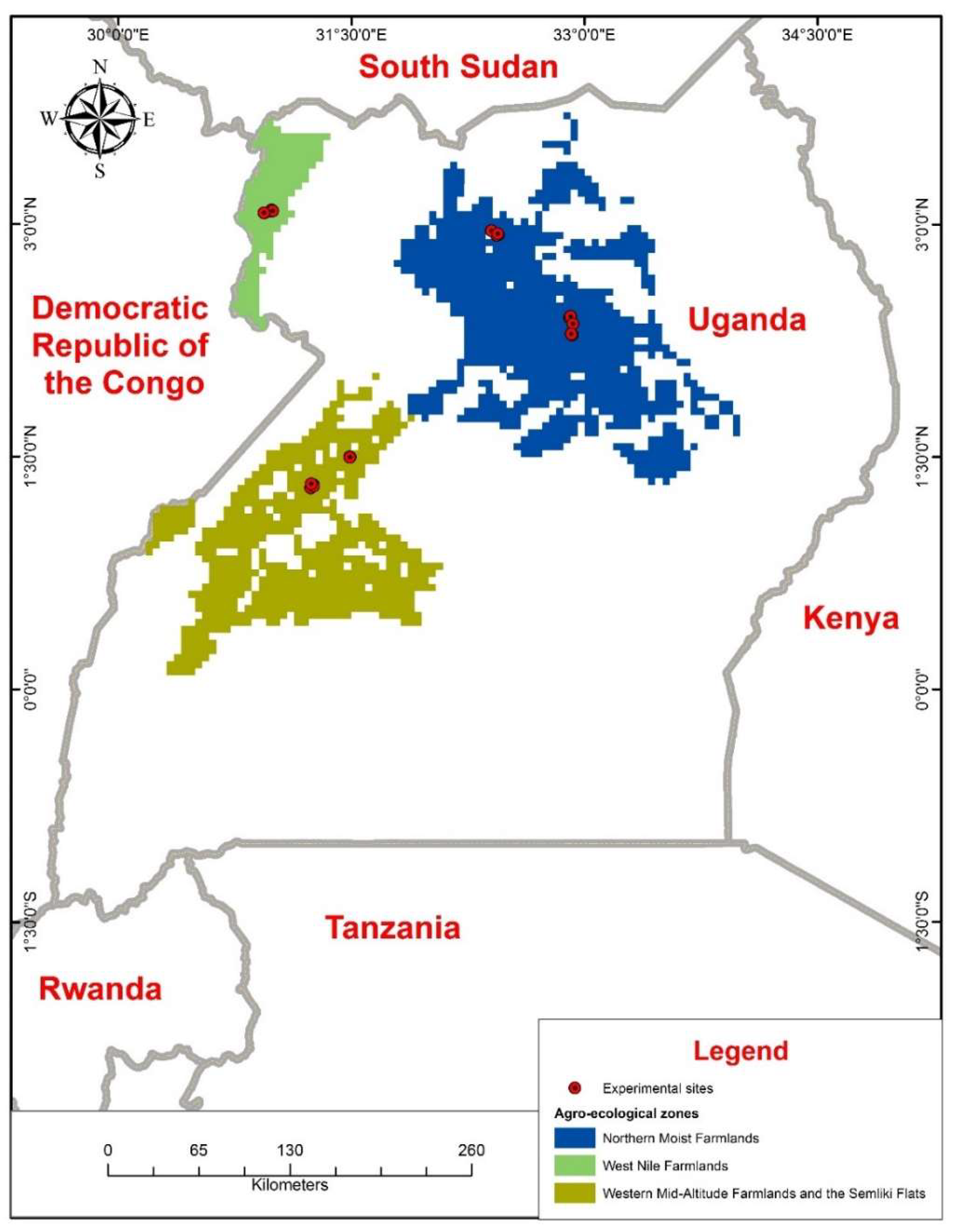

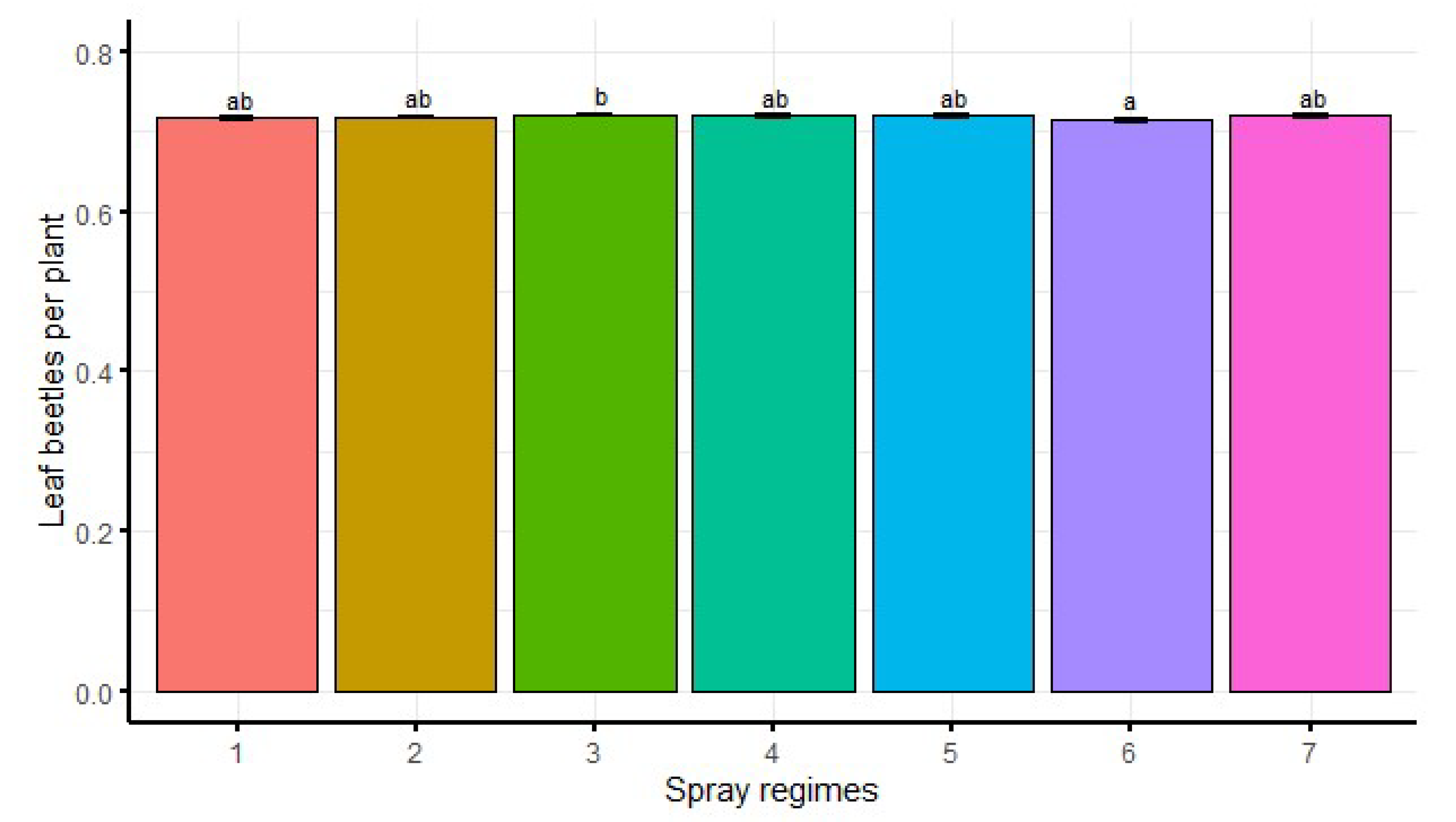
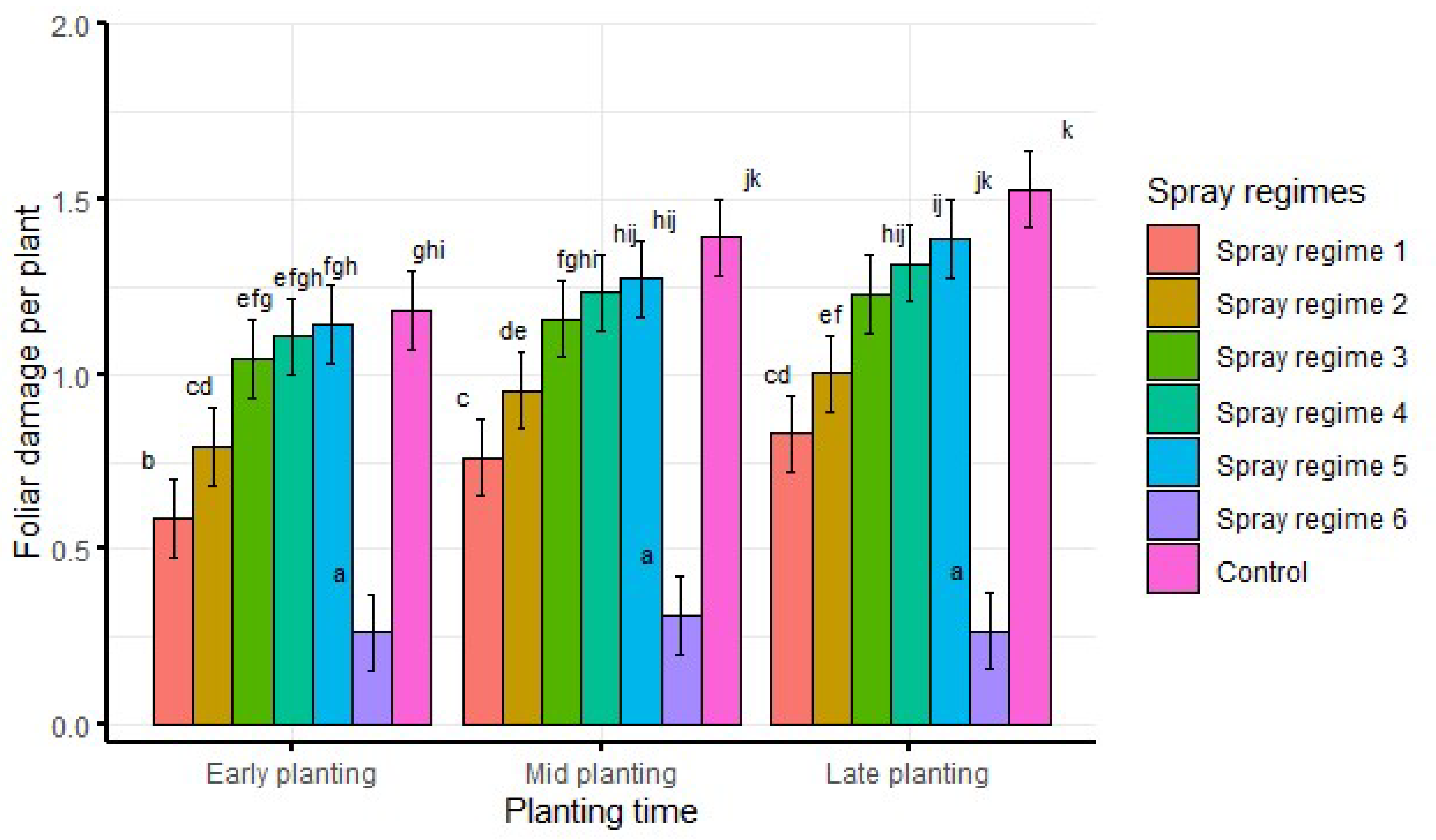


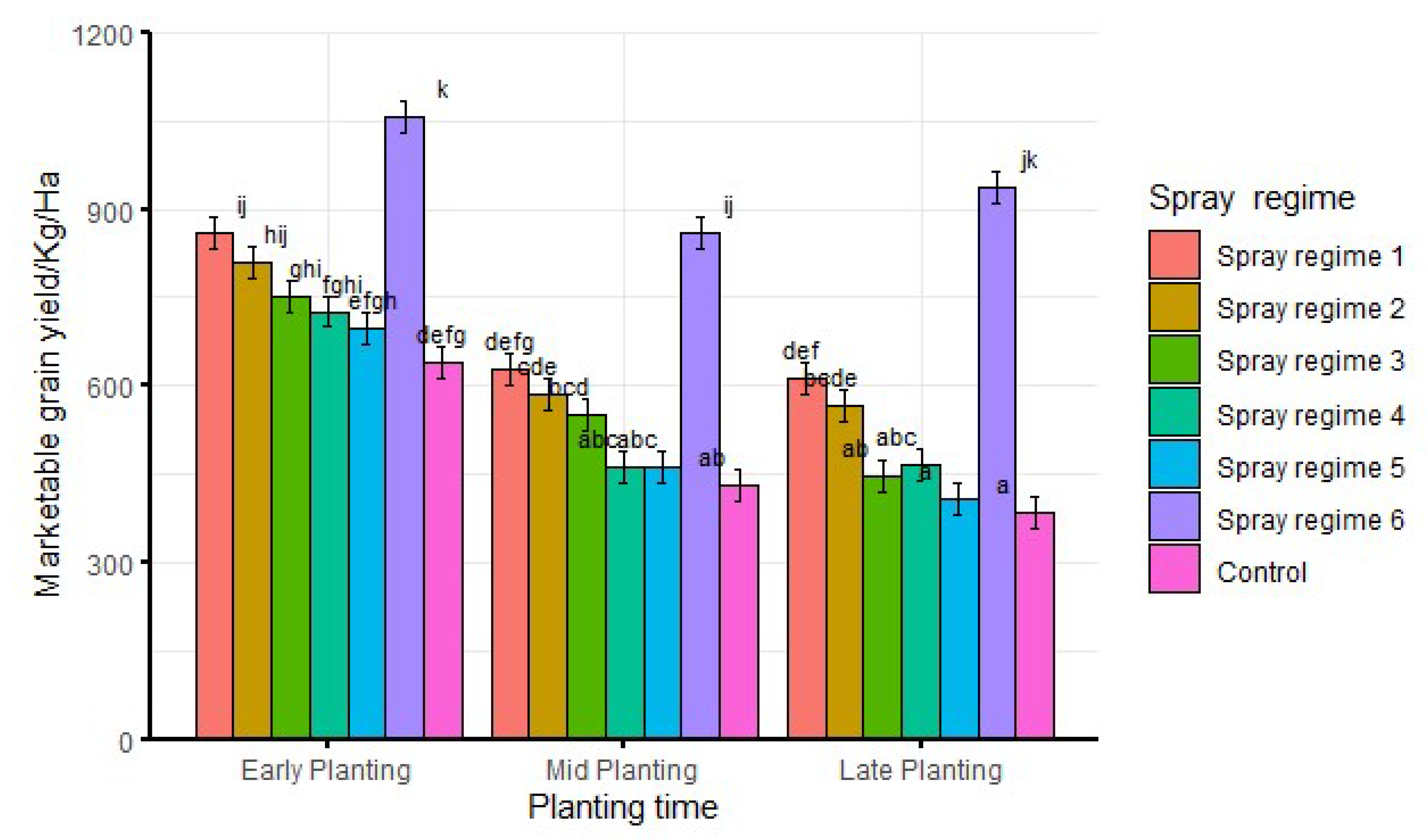
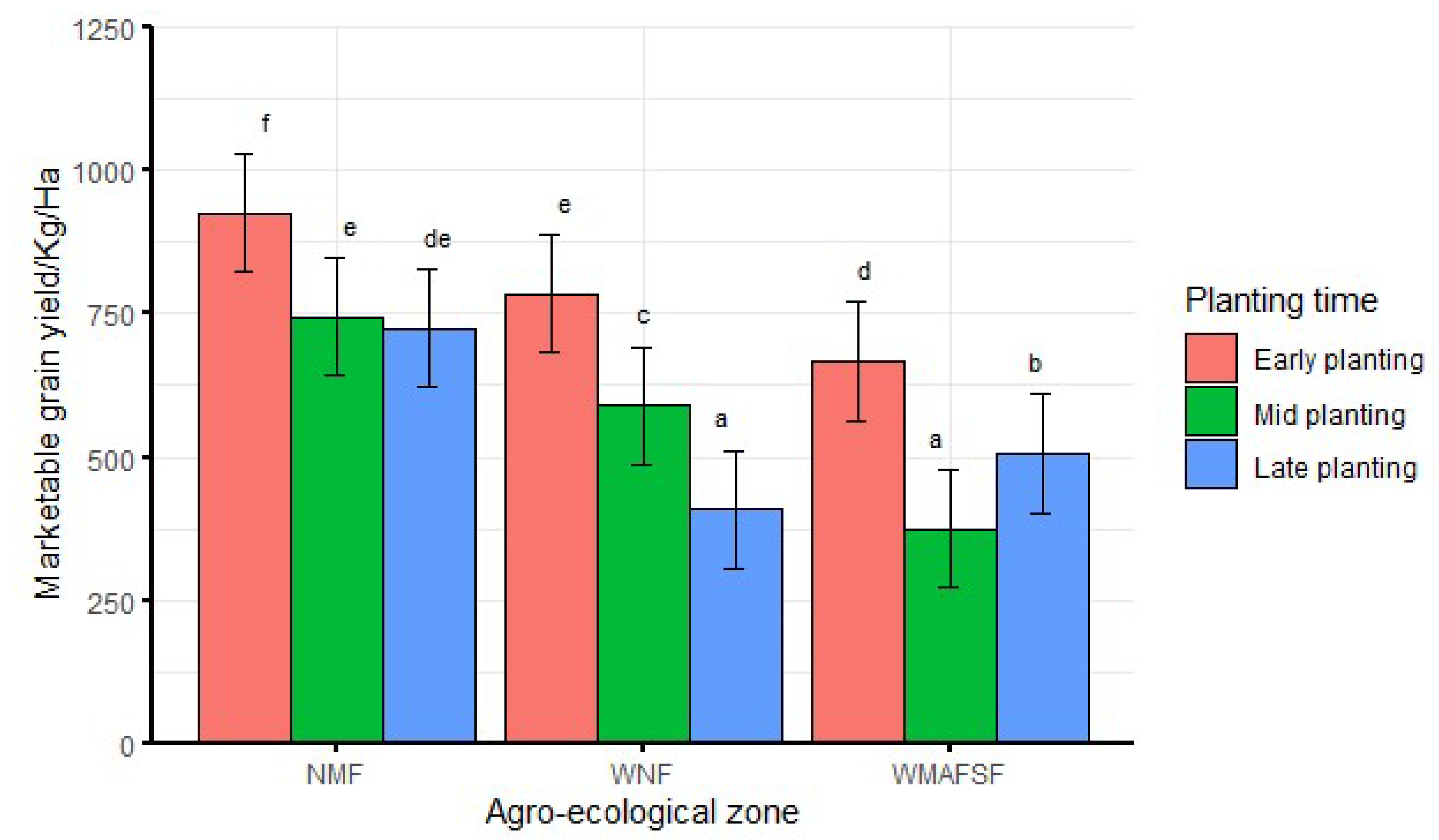
| Season | Agro-Ecological Zone | District | Planting Time | Planting Date |
|---|---|---|---|---|
| 2016 | NMF | Lira | Early planting | 18 July 2016 |
| Mid planting | 2 August 2016 | |||
| Late planting | 10 September 2016 | |||
| WNF | Arua | Early planting | 12 July 2016 | |
| Mid planting | 2 August 2016 | |||
| Late planting | 15 August 2016 | |||
| WMAFSF | Hoima | Early planting | 25 August 2016 | |
| Mid planting | 10 September 2016 | |||
| Late planting | 7 October 2016 | |||
| 2017 | NMF | Lira | Early planting | 8 April 2017 |
| Mid planting | 23 April 2017 | |||
| Late planting | 23 May 2017 | |||
| Gulu | Early planting | 7 April 2017 | ||
| Mid planting | 27 April 2017 | |||
| Late planting | 25 May 2017 | |||
| WNF | Arua | Early planting | 24 April 2017 | |
| Mid planting | 26 May 2017 | |||
| Late planting | 24 June2017 | |||
| WMAFSF | Hoima | Early planting | 4 April 2017 | |
| Mid planting | 20 April 2017 | |||
| Late planting | 23 May 2017 |
| Season | Agro-Ecological Zone | Planting Time | ||
|---|---|---|---|---|
| Early Planting | Mid Planting | Late Planting | ||
| 2016 | NMF | 0.710 ± 0.003 a | 0.709 ± 0.003 a | 0.710 ± 0.003 a |
| WNF | 0.713 ± 0.003 ab | 0.736 ± 0.003 d | 0.713 ± 0.003 ab | |
| WMAFSF | 0.711 ± 0.003 a | 0.709 ± 0.003 a | 0.709 ± 0.003 a | |
| 2017 | NMF | 0.738 ± 0.003 de | 0.747 ± 0.003 ef | 0.722 ± 0.003 bc |
| WNF | 0.729 ± 0.003 cd | 0.748 ± 0.003 f | 0.716 ± 0.003 ab | |
| WMAFSF | 0.709 ± 0.003 a | 0.708 ± 0.003 a | 0.708 ± 0.003 a | |
| Season | Agro-Ecological Zone | Planting Time | ||
|---|---|---|---|---|
| Early Planting | Mid Planting | Late Planting | ||
| 2016 | NMF | 0.75 ± 0.11 bc | 0.92 ± 0.11 cde | 0.92 ± 0.11 cde |
| WNF | 0.79 ± 0.11 bc | 1.16 ± 0.11 fg | 0.99 ± 0.11 de | |
| WMAFSF | 1.33 ± 0.11 h | 1.06 ± 0.11 ef | 1.55 ± 0.11 i | |
| 2017 | NMF | 1.09 ± 0.11 ef | 1.05 ± 0.11 ef | 1.28 ± 0.11 gh |
| WNF | 0.75 ± 0.11 b | 1.08 ± 0.11 ef | 0.88 ± 0.11 bcd | |
| WMAFSF | 0.53 ± 0.11 a | 0.79 ± 0.11 bc | 0.86 ± 0.11 bcd | |
| Season | Agro-Ecological Zone | Spray Regimes | ||||||
|---|---|---|---|---|---|---|---|---|
| Spray Regime 1 | Spray Regime 2 | Spray Regime 3 | Spray Regime 4 | Spray Regime 5 | Spray Regime 6 | Control | ||
| 2016 | NMF | 0.66 ± 0.10 def | 0.88 ± 0.10 fghijkl | 1.04 ± 0.10 ijklmno | 1.08 ± 0.10 klmnop | 1.12 ± 0.10 nopq | 0.10 ± 0.10 a | 1.18 ± 0.10 mnopqr |
| WNF | 0.90 ± 0.10 ghijkl | 0.98 ± 0.10 ijklmno | 1.10 ± 0.10 klmnop | 1.21 ± 0.10 opqr | 1.20 ± 0.10 nopqr | 0.12 ± 0.10 a | 1.36 ± 0.10 qrs | |
| WMAFSF | 0.86 ± 0.10 fghijk | 1.18 ± 0.10 mnopqr | 1.68 ± 0.10 tu | 1.65 ± 0.10 tu | 1.68 ± 0.10 tu | 0.36 ± 0.10 bc | 1.81 ± 0.10 u | |
| 2017 | NMF | 0.73 ± 0.10 efgh | 0.99 ± 0.10 hijklmno | 1.28 ± 0.10 pqr | 1.38 ± 0.10 rs | 1.53 ± 0.10 st | 0.48 ± 0.10 cd | 1.60 ± 0.10 stu |
| WNF | 0.72 ± 0.10 defg | 0.84 ± 0.10 fghij | 0.97 ± 0.10 hijklmn | 1.08 ± 0.10 klmnop | 1.12 ± 0.10 lmnopq | 0.40 ± 0.10 bc | 1.20 ± 0.10 nopqr | |
| WMAFSF | 0.50 ± 0.10 cde | 0.65 ± 0.10 def | 0.80 ± 0.10 fghi | 0.90 ± 0.10 ghijkl | 0.94 ± 0.10 ghijklm | 0.23 ± 0.10 ab | 1.06 ± 0.10 jklmnop | |
| Season | Planting Time | Spray Regimes | ||||||
|---|---|---|---|---|---|---|---|---|
| Spray Regime 1 | Spray Regime 2 | Spray Regime 3 | Spray Regime 4 | Spray Regime 5 | Spray Regime 6 | Control | ||
| 2016 | Early planting | 0.62 ± 0.11 cd | 0.89 ± 0.11 efgh | 1.19 ± 0.11 ijklmno | 1.23 ± 0.11 jklmno | 1.27 ± 0.11 klmnop | 0.21 ± 0.11 a | 1.31 ± 0.11 mnopq |
| Mid planting | 0.84 ± 0.11 defg | 1.02 ± 0.11 ghijk | 1.28 ± 0.11 lmnop | 1.30 ± 0.11 mnopq | 1.32 ± 0.11 nopq | 0.09 ± 0.11 a | 1.50 ± 0.11 pq | |
| Late planting | 0.96 ± 0.11 fghi | 1.12 ± 0.11 hijklmn | 1.35 ± 0.11 nopq | 1.42 ± 0.11 opq | 1.42 ± 0.11 opq | 0.27 ± 0.11 a | 1.55 ± 0.11 qs | |
| 2017 | Early planting | 0.55 ± 0.11 bc | 0.70 ± 0.11 cde | 0.90 ± 0.11 efgh | 0.98 ± 0.11 ghij | 1.02 ± 0.11 ghijk | 0.31 ± 0.11 ab | 1.06 ± 0.11 ghijklm |
| Mid planting | 0.69 ± 0.11 cde | 0.89 ± 0.11 efgh | 1.04 ± 0.11 ghijkl | 1.17 ± 0.11 ijklmno | 1.23 ± 0.11 jklmno | 0.54 ± 0.11 bc | 1.29 ± 0.11 lmnop | |
| Late planting | 0.70 ± 0.11 cdef | 0.89 ± 0.11 efgh | 1.11 ± 0.11 hijklmn | 1.22 ± 0.11 jklmno | 1.36 ± 0.11 nopq | 0.26 ± 0.11 a | 1.50 ± 0.11 pq | |
| Season | Agro-Ecological Zone | Planting Time | ||
|---|---|---|---|---|
| Early Planting | Mid Planting | Late Planting | ||
| 2016 | NMF | 921 ± 103 i | 334 ± 103 bc | 140 ± 103 a |
| WNF | 820 ± 103 gh | 449 ± 103 def | 412 ± 103 cde | |
| WMAFSF | 890 ± 103 hi | 463 ± 103 def | 503 ± 103 ef | |
| 2017 | NMF | 928 ± 103 i | 1154 ± 103 j | 1307 ± 103 k |
| WNF | 749 ± 103 g | 728 ± 103 g | 406 ± 103 cd | |
| WMAFSF | 443 ± 103 def | 286 ± 103 b | 509 ± 103 f | |
| Season | Agro-Ecological zone | Spray Regimes | ||||||
|---|---|---|---|---|---|---|---|---|
| Spray Regime 1 | Spray Regime 2 | Spray Regime 3 | Spray Regime 4 | Spray Regime 5 | Spray Regime 6 | Control | ||
| 2016 | NMF | 508 ± 106 defghij | 474 ± 106 cdefghi | 424 ± 106 bcdefg | 419 ± 106 bcdefg | 390 ± 106 bcdef | 656 ± 106 jkl | 386 ± 106 bcdef |
| WNF | 620 ± 106 hijk | 643 ± 106 ijkl | 527 ± 106 efghij | 492 ± 106 defghij | 487 ± 106 defghij | 811 ± 106 lmn | 342 ± 106 abcd | |
| WMAFSF | 631 ± 106 hijk | 611 ± 106 hijk | 612 ± 106 hijk | 547 ± 106 fghijk | 521 ± 106 efghij | 928 ± 106 no | 480 ± 106 cdefghi | |
| 2017 | NMF | 1207 ± 106 p | 1182 ± 106 p | 1005 ± 106 o | 995 ± 106 o | 1002 ± 106 o | 1526 ± 106 q | 990 ± 106 o |
| WNF | 713 ± 106 klm | 624 ± 106 hijk | 579 ± 106 ghijk | 549 ± 106 fghijk | 465 ± 106 cdefgh | 933 ± 106 no | 531 ± 106 fghij | |
| WMAFSF | 519 ± 106 efghij | 392 ± 106 bcedf | 354 ± 106 abcde | 308 ± 106 abc | 274 ± 106 ab | 853 ± 106 mno | 188 ± 106 a | |
| Season | Planting Time | Spray Regimes | ||||||
|---|---|---|---|---|---|---|---|---|
| Spray Regime 1 | Spray Regime 2 | Spray Regime 3 | Spray Regime 4 | Spray Regime 5 | Spray Regime 6 | Control | ||
| 2016 | 1 | 906 ± 107 nopqr | 950 ± 107 opqr | 898 ± 107 nopq | 819 ± 107 lmnop | 777 ± 107 ijklmno | 1087 ± 107 r | 702 ± 107 ghijklm |
| 2 | 461 ± 107 bcdef | 379 ± 107 abc | 347 ± 107 ab | 354 ± 107 ab | 355 ± 107 ab | 726 ± 107 ghijklmn | 286 ± 107 ab | |
| 3 | 392 ± 107 abcd | 399 ± 107 abcde | 317 ± 107 ab | 285 ± 107 ab | 266 ± 107 a | 582 ± 107 efgh | 220 ± 107 a | |
| 2017 | 1 | 812 ± 107 klmnop | 668 ± 107 ghijklm | 605 ± 107 fghi | 634 ± 107 fghijk | 620 ± 107 fghij | 1025 ± 107 qr | 580 ± 107 efgh |
| 2 | 794 ± 107 jklmno | 796 ± 107 jklmno | 756 ± 107 hijklmn | 571 ± 107 defg | 570 ± 107 defg | 994 ± 107 pqr | 578 ± 107 efgh | |
| 3 | 833 ± 107 mnop | 733 ± 107 ghijklmn | 647 ± 107 defgh | 647 ± 107 ghijkl | 552 ± 107 cdefg | 1294 ± 107 s | 551 ± 107 cdefg | |
| Season | Agro-Ecological Zone | Site | Planting Time | Intercept | Slope | R2 | p-Value |
|---|---|---|---|---|---|---|---|
| 2016 | NMF | On farm | Early planting | 1012.6 | −45.7 | 0.0079 | 0.251 |
| Mid planting | 429.8 | −136.9 | 0.2874 | p < 0.001 | |||
| Late planting | 270.0 | −129.8 | 0.2693 | p < 0.001 | |||
| On station | Early planting | 952.2 | −116.3 | 0.0534 | p < 0.05 | ||
| Mid planting | 674.8 | −335.9 | 0.4986 | p < 0.001 | |||
| Late planting | 229.0 | −110.6 | 0.2907 | p < 0.001 | |||
| WNF | On farm | Early planting | 1018.8 | −262.1 | 0.1604 | p < 0.001 | |
| Mid planting | 348.6 | 13.5 | 0.0025 | 0.516 | |||
| Late planting | 478.1 | −91.5 | 0.1170 | p < 0.001 | |||
| On station | Early planting | 973.8 | −194.7 | 0.1631 | p < 0.001 | ||
| Mid planting | 892.1 | −305.9 | 0.3352 | p < 0.001 | |||
| Late planting | 611.0 | −181.0 | 0.2188 | p < 0.001 | |||
| WMAFSF | On farm | Early planting | 1292.7 | −93.4 | 0.0328 | p < 0.05 | |
| Mid planting | 1000.2 | −142.7 | 0.0610 | p < 0.05 | |||
| Late planting | 589.8 | −119.3 | 0.3493 | p < 0.001 | |||
| On station | Early planting | 836.7 | −144.3 | 0.2170 | p < 0.001 | ||
| Mid planting | 182.4 | −96.1 | 0.2970 | p < 0.001 | |||
| Late planting | 836.7 | −144.3 | 0.2170 | p < 0.001 | |||
| 2017 | NMF | On farm | Early planting | 1338.6 | −134.4 | 0.0154 | 0.109 |
| Mid planting | 1847.6 | −235.3 | 0.0380 | p < 0.05 | |||
| Late planting | 2165.6 | −427.9 | 0.3218 | p < 0.001 | |||
| On station | Early planting | 650.2 | −2.1 | 0.00002 | 0.952 | ||
| Early planting | 885.5 | −156.2 | 0.1406 | p < 0.001 | |||
| Late planting | 1160.5 | −146.1 | 0.1914 | p < 0.001 | |||
| WNF | On farm | Early planting | 889.1 | −140.3 | 0.0394 | p < 0.05 | |
| id planting | 1287.7 | −132.1 | 0.0471 | p < 0.05 | |||
| Late planting | 846.1 | −94.6 | 0.0536 | p<0.05 | |||
| On station | Early planting | 884.9 | −203.2 | 0.2155 | p < 0.001 | ||
| Mid planting | 353.2 | −38.2 | 0.0116 | 0.164 | |||
| Late planting | 84.1 | −40.0 | 0.1099 | p < 0.001 | |||
| WMAFSF | On farm | Early planting | 295.3 | −109.7 | 0.0765 | p < 0.001 | |
| Mid planting | 354.9 | −282.7 | 0.2741 | p < 0.001 | |||
| Late planting | 1033.6 | −587.8 | 0.2150 | p < 0.001 | |||
| On station | Early planting | 831.4 | −285.2 | 0.2360 | p < 0.001 | ||
| Mid planting | 397.0 | −72.9 | 0.1075 | p < 0.001 | |||
| Late planting | 757.9 | −404.4 | 0.5206 | p < 0.001 |
Publisher’s Note: MDPI stays neutral with regard to jurisdictional claims in published maps and institutional affiliations. |
© 2022 by the authors. Licensee MDPI, Basel, Switzerland. This article is an open access article distributed under the terms and conditions of the Creative Commons Attribution (CC BY) license (https://creativecommons.org/licenses/by/4.0/).
Share and Cite
Halerimana, C.; Kyamanywa, S.; Olaboro, S.; Paparu, P.; Nkalubo, S.T.; Colvin, J.; Cheke, R.A.; Kriticos, D.J.; Otim, M.H. Bean Leaf Beetle (Ootheca spp.) (Coleoptera: Chrysomelidae) Management via Planting Timing and Insecticides. Insects 2022, 13, 709. https://doi.org/10.3390/insects13080709
Halerimana C, Kyamanywa S, Olaboro S, Paparu P, Nkalubo ST, Colvin J, Cheke RA, Kriticos DJ, Otim MH. Bean Leaf Beetle (Ootheca spp.) (Coleoptera: Chrysomelidae) Management via Planting Timing and Insecticides. Insects. 2022; 13(8):709. https://doi.org/10.3390/insects13080709
Chicago/Turabian StyleHalerimana, Charles, Samuel Kyamanywa, Samuel Olaboro, Pamela Paparu, Stanley T. Nkalubo, John Colvin, Robert A. Cheke, Darren J. Kriticos, and Michael H. Otim. 2022. "Bean Leaf Beetle (Ootheca spp.) (Coleoptera: Chrysomelidae) Management via Planting Timing and Insecticides" Insects 13, no. 8: 709. https://doi.org/10.3390/insects13080709







